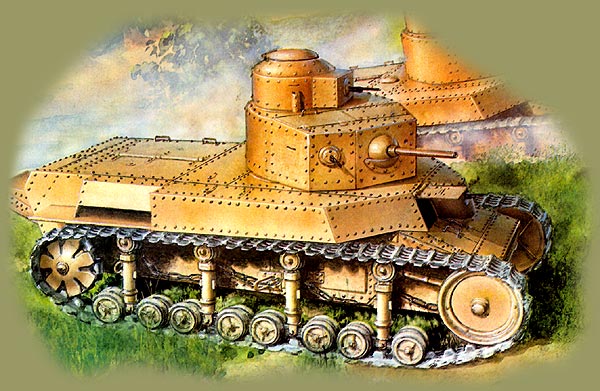In course of the Russian Civil War deployment of tanks in comparison to armored trains had very limited extent. Despite this the "Centrobron", an organization specially formed by Soviet Government, from the very beginning gave full attention to fighting tracked vehicles, expecting their major role in the future.
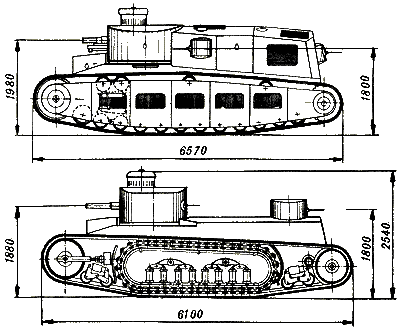
Paper projects of very first Soviet tanks. (GUVP) |
Conditions of open competition for the design of a tank for Red Army were published in the journal "Izvestya Narodnogo Kommisariata po Voennym Dyelam" on November 2nd, 1919 (News of the People's Commissariat of Military Affairs). The first prize was given to 10-ton amphibious tank under designation "Motor vessel type AM", designed by G.V. Kondratiev. Production of two units started at Izhorskyi Factory, though they were not completed. Contrary to the modifications of French tank "Renault FT17/18" produced by Sormovo Factory, Kondratiev' tank was completely new design. The second competition in 1922 brought 7 more designs. It turns out that tank designing was very prolific despite that the country's economy was not ready for experimental tank production.
In 1923 GUVP VSNH took a task to systematize expertise in designing the tanks. A year later within OAT the Moscow Tank Bureau was set up with S.P. Shukalov as a head. Among various designs produced were 10-ton tank GUVP-1 and 16-ton tank GUVP-2. The first one bore resemblance of armored train platform with a turret at the end set on tracks. Rear and mid parts formed a casemate, preventing fire rearwards since it was assumed that during break through the enemy defenses the targets worthy a 3-inch shell will be in front or at the flanks. The whole area around the tank was covered by fire from six machine-guns. The tank had 13-mm thick armor, crew of 6, and according to estimates the top speed should be 20 km/h. Configuration of the GUVP-2 was inspired by the French tank 2C, however 45-mm cannon in the front turret could cover almost full field around the tank, except small area at the back due to location of the rear machine gun turret. New suspension was designed, to allow for top speed of 20 km/h. Tank was to be fitted with four machine-guns, 22-mm thick armor and crew of 5.
|
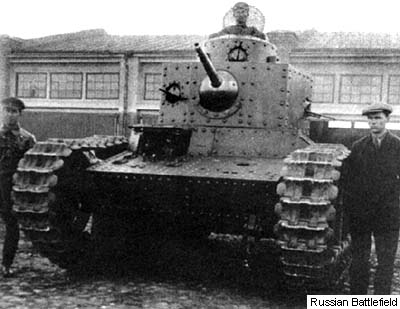
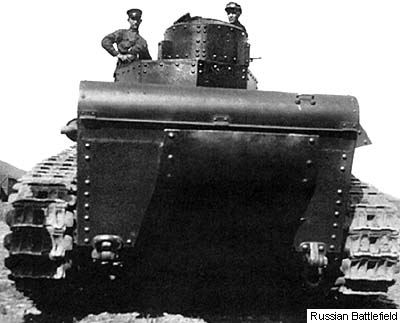
The T-12 tank during trials at Kharkov. June 1930. (M.Kolomiets) |
However army required new equipment for the armed forces immediately. At that time the Red Army possessed some obsolete and heavily worn-out French and British captured tanks. By April 1925 situation with armament of tanks became critcal as well. For example, only 10% of all Ricardo (Mk.V) tanks were supplied with 57-mm Hotchkiss gun (other 90% were unarmed); all Renault FT-17 whihich must be armed with cannons in fact were unarmed. As temporary measure fitting Maxim machine-guns was proposed.
On October 24th, 1925 a meeting on tank production and arrangement of the tank design works was held in the Mobilization and Planning Directorate of the Red Army. As a conclusion it was decided to put on hold design of "big" or "positional" tank (means heavy tank) and allocate all resources to design "maneuverable" or "small" tank. The latter one, under designation T-16 passed general trials and on May 6th, 1927, by the decision of the RVS of USSR was accepted for service for the armed forces and since then was known as T-18 (MS-1).
The task of design and manufacture of maneuverable tank was awarded to OAT on November 17th, 1927, on the condition that during manufacturing of the tank in KhPZ, the OAT will provide technical assistance.
The tank design bureau at the KhPZ factory was set up in October 1926, but it did not have expertise in designing tanks as the factory had only manufactured steam engines and "Communar" tractors in the past. Therefore, the design work was divided between KhPZ and OAT: The transmission and the traction were designed in Kharkov, the hull and the turret were designed in Moscow. The OAT was not enthusiastic about designing the T-12 (the designation awarded to the manoeuvrable tank) and succeeded in transferring part of its work to the Kharkov designers. For more than six months, they worked in Moscow under the direction of OAT Chief Designer S. Shukalov and Lead Designer O. Ivanov. Among other things, they designed the turret, the hull, the crew positions, the armament mounts, and the vision arrangements. Engineer N.M. Toskin, a representative of OAT, took part in the design of the T-12 in Kharkov. From October 1928, 23-year old draftsman Alexander Morozov joined the design team. Later he became a director of the tank design bureau at KhPZ, became an outstanding designer, and became twice a Hero of Socialist Work.
The T-12 was the result of combining expertise gained during the design of the T-18 tank and the concept of a multi-level layout of armament recently employed by the Americans in their experimental T.1.E1 tank (1921-1925). Originally, the T-12 was to be equipped with a 45-mm long-barrelled cannon or a 57-mm howitzer, and three Fedorov twin machine-gun mountings. All armament was located in two levels in the turrets; a main turret, and an independently-rotating small turret with machine guns. A serious shortcoming of this concept was that the movement of the main turret seriously affected the control of the smaller one. The multi-turret design also resulted in an overall height of three meters, which gave a high profile and which made camouflaging difficult.
The empty weight of the tank was 14,280 kg. While combat ready, with the crew of four, the ammunition (100 shells for the main gun and 4,000 rounds for the machine-guns), and the fuel, etc., the ground pressure was 0.45 kg/cm2. It was planned to use an eight-cylinder aviation Hispano engine with 200 h.p. at 1500 r.p.m., with an option to replace it by a purposely-made engine with 180 h.p. at 1800 r.p.m. In the engine compartment, a track-tensioning device was housed.
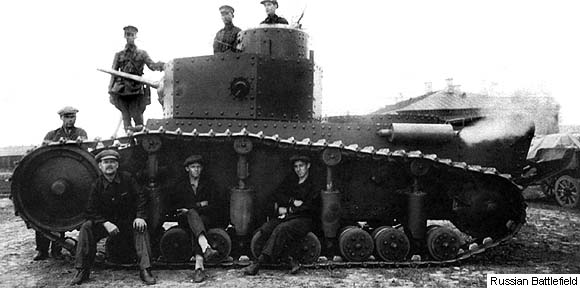
T-12 tank during trials at Kharkov.
This vehicle is armed with a 45-mm main gun Model 1930 and three machine-guns DT. June 1930. (M.Kolomiets)
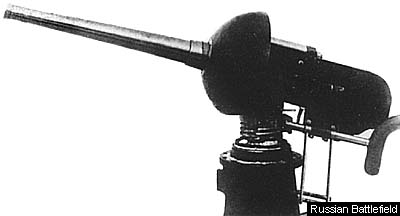
45-mm main gun Model 1930
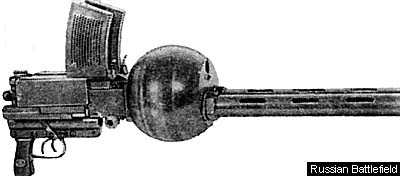
6.5mm coupled machine-gun Fedorov-Ivanov Model 1925 |
An unusual feature of the T-12 was the location of the driver, which was to the left from the longitudinal axis of the tank, and which differed from other Soviet tanks. The top speed was 26 km/h, and with an epicyclic gear mechanism, it could be converted to 15 km/h, 7 km/h and 2.7 km/h with reverse drive at all speeds. A new feature was a floating brake designed by professor V.I. Zaslavskyi.
The vertical armor plates were 22-mm thick, while the horizontal armor plates were 12-mm thick. The main turret was mechanically operated, while the small machine-gun turret was traversed by means of a back support.
The T-12, as its predecessor the T-18, had a rear extension fitted, increasing its total length to 6.90 metres which allowed the tank to cross trenches up to 2.65 metres wide. The maximum ascent angle was 40°.
On July 11, 1930, Commisar Voroshilov, the head of UMM Khalepskiy and the head of the UMM Technical Department Bokis, observed the tank's field trials. The tank passed the trials successfully. A speed of 26 km/h was easily attained on hard ground, and two-metre-wide trenches were crossed. During the trials, a Colt machine-gun was fitted in a Shpagin ball mounting as the Soviet-made DT machine-gun was not yet ready for the trials.
Good fire concentration was noted as 60% hits on target were recorded. A number of faults were listed as well: the tracks easily slipped off; after 20 gear changes, the speed decreased; after 90 litres of petrol were consumed, the fuel flow stopped despite the fact that there were still 130 litres left in the cells. Nevertheless, the overall assessment was positive, the tank fulfilled the requirements, and it was recommended to be used by the army after the problems had been rectified.
At the same time, the 22-mm and 18-mm armor plates were subjected to artillery fire and they proved sufficiently resistant. The plant Chief Engineer C.N. Makhonin and the design bureau head I. N. Aleksenko, signed the trial certificates. Following their recommendations, the design bureau of the GKhPZ factory implemented the changes and the modified machine received the new T-24 designation. The main reason behind the significant changes was the insufficient range of the tank.
|
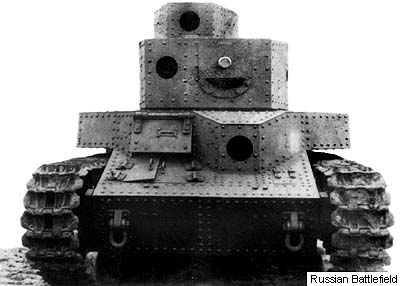
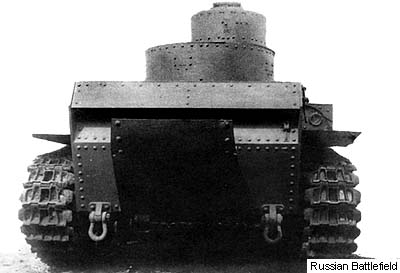
T-24 medium tank (front and rear view). 1940. (M.Kolomiets) |
Previous to this, on March 27, 1930, during a meeting of the UMM of the RKKA, the decision was made to manufacture a series of fifteen T-24s. The first three tanks were ready by the end of July 1930, and one of them was sent for comparative trials with the T-12.
The first day of trials on July 24, 1930, was uneventful, and the tank's performance was similar to the T-12. Three days of trials were planned for the 45-mm Sokolov Cannon which was mounted in a turret taken from a T-12 tank, but an extraordinary incident occurred. On July 26, while the tank carrying the cannon with ten shells was driving on soft ground, the engine set on fire. The report of this incident sent to Commissar Voroshilov states:
"Comrade Vladimirov stopped the tank, helped the crew to abandon the tank, opened the engine compartment, extinguished 75% of the flames with the tank's fire extinguisher, then put on a gas mask, returned to the engine compartment and put out the fire using sand and personal clothing."
The tank was saved, but it had to be repaired before further trials could proceed. The turret was transferred back to the T-12. The 45-mm Sokolov Cannon, fitted in the tank in 1930 as a temporary measure (until the introduction of the 45-mm semi-automatic GUVP Tank Cannon Model 1925 approved in the Artillery Committee Journal #693 from 18.06.26), turned out to be unsuitable for tanks and was not produced, and it is believed that only two of the cannons were manufactured. Readying the production line for the 45-mm OAT Cannon in Factory #8 took another two years. Peter Syatchintov elliminated the 57-mm howitzer's shortcomings, but the howitzer was not ordered for production, and some of its details were incorporated into the 76.2mm PS-3 Cannon.
The combat weight of the T-24 was 24.5 tonnes. The tank had 20mm-thick vertical armor and 8.5mm-thick horizontal armor, which provided protection against heavy machine-gun fire at all distances. The main turret was cylindrical, and at the top of the smaller turret, there was a covered hatch. The Soviet-made 300 h.p. M6 aviation engine was fitted. The transmission compartment was similar to the one in the "Komintern" artillery tractor. The transmission unit included a main friction clutch, a epicyclic gearbox, a double universal joint for reverse running and two side gears. The transmission unit was manufactured to a very high standard.
|
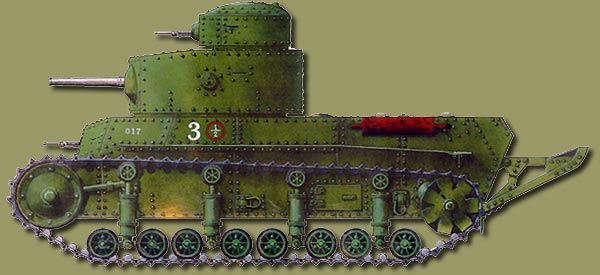
T-24 on the maneuvers of the Kharkov Military District. 1933. (A.Aksenov)
The KhPZ and ChTZ factories were chosen to produce the T-24 tanks. It was planned to manufacture 200 tanks from 1930 to 1931, but as it was common to increase production targets in those days, the target was increased to 300. The actual production numbers were much lower: 28 chassis, 25 hulls, 26 turrets, and 24 complete tanks were completed and accepted for service. Why so few? The tank obviously suffered from a series of faults, preventing it from being mass-produced, though the main reason was different. Numerous shortcomings did not stop the T-18, the T-26, and other tanks from being manufactured in large numbers.
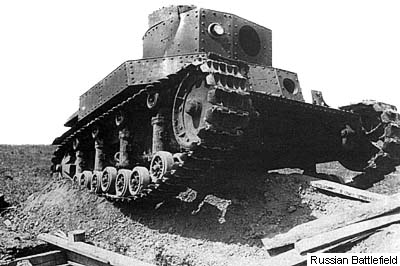
T-24 on trials. July 18, 1931. (M.Kolomiets) |
In RGVA archives, there is correspondence (from November 1930 to February 1932) between Khalepskiy, Zaslavskiy and Voroshilov, which indicates that the Head of the UMM was impressed by the "Grote tank," as Khalepskiy called the experimental middleweight tank designed by German engineer E. Grote. He praised it, pointing out that it had better armament, drivability, steering ability, appearance and simplicity of manufacture in comparison not only with the T-12/T-24 but also with tanks "designed by an American, Mr. Christie, which I saw in the United States last year." Comrade Zaslavskiy, responsible for manufacturing the T-24, complained to Voroshilov that little attention was being paid towards production. Comrade Voroshilov advised Zaslavskiy to use his own resources and asked Khalepskiy: "when will the new and badly needed [Grote] tanks join Read Army units?" It went on for one year, while the manufacturing plant waited for materials and financing, the top brass were waiting for the completion of the trials of the Grote Tank, and were waiting to review the results. In the end, the Grotte tank was not manufactured and the production capacity of the KhPZ Factory was allocated for manufacturing the Christie Tank, but production of the Christie tank was soon ended by Khalepskiy.
The 45-mm cannon for the T-24 was ready in 1932. Before this, the tank was armed with machine-guns only (the BT tanks, manufactured in the KhPZ Factory beginning in 1931, were armed only with machine-guns as well). In the Red Army, the T-24s were used originally as support tanks, but were shortly relegated to training duties. They did not participate in any military conflicts.
|
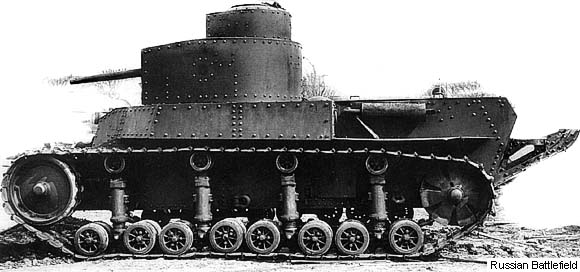
Production tank T-24 at NIIBT Poligon proving ground.
In the late twenties and the early thirties, when the Soviet tank industry was just emerging, new concepts were created, cadres were formed, and a whole range of tank models from the tankette T-17 to the middleweight Grote tank were produced. Among these, there was the T-24, the first Soviet-made medium tank. The new models helped in determining optimal relations between armor, armament, speed, maneuverability, etc. Many transmission systems, suspensions, and various types of tracks were tested, and different types of armament and mountings were tried out. Literally everything was done for the first time. Obviously, at that stage, to come up with a perfect design was difficult, and to achieve it quickly was impossible. The first Soviet tanks suffered from problems related to the power and transmission units, to slipping tracks, to traction, and to steering. The only early tank manufactured in quantity was the T-18, and it was popular with the crews.
The T-24 tank was taken off the production line as technical shortcomings and maintenance problems became evident. Nevertheless, it played a significant role in the history of the national tank industry. The early designs, the first tanks, and their manufacture brought experience that was vital to the creation of a strong Soviet tank industry.
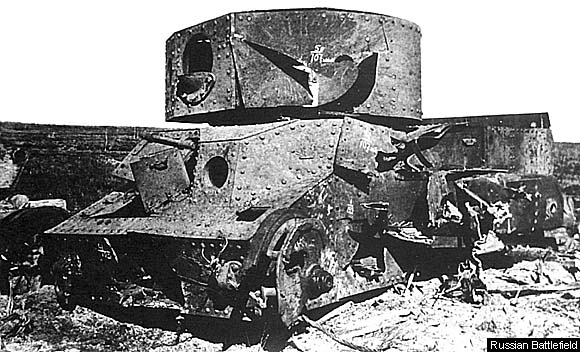
The dismal end of the T-24: it was disarmed and used for artillery trials. (M.Kolomiets)
Interior Layout of the T-24
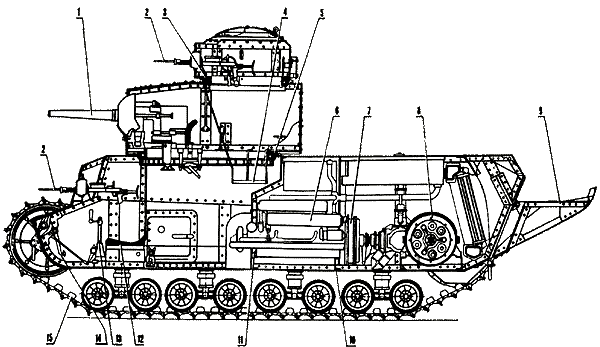
1. The 45-mm main gun;
2. The 7,62-mm machine-gun DT;
3. The ball-bearing turret race for small turret;
4. Sliding floor for the small turret;
5. The ball-bearing turret race for big turret;
6. The M-6 engine;
7. The main friction clutch;
8. The differential gear coupled with a belt brakes; |
9. The tail;
10. The engine sub-frame;
11. The engine compartment' partition;
12. The driver's station;
13. The steering column;
14. The steering pedals;
15. The track. |
|
Translated by:
Krzysztof Pawlowski
Sources:
M.Pavlov, I.pavlov, I.Zheltov "Sovetskie Tanki Dovoennogo Perioda" Armada-Vertical #7, 2000;
"Tankomaster" #1, 2001;
"Modelist-Konstruktor" #9, 1989
M.Svirin, A.Beskurnikov "Pervye Sovietskie Tanki", Armada #1
|
|



